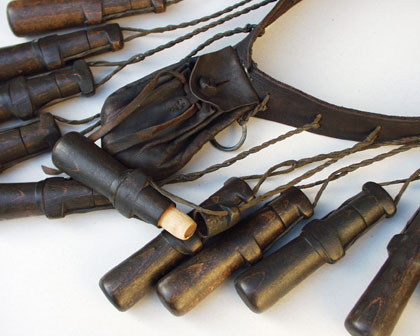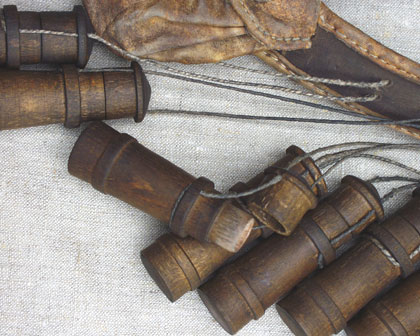Bullet pouch of soft leather for appr. 10 bullets und cleaning jag
The proportion of powder used with 17. century matchlock muskets usually required was half the weight of the bullet. This meant, that by using a bullet of 16,8 mm calibre (18 bullets to the Nurnberg pound rolling in), which were shot from musket bores (in use in franconian territorys by 1634) of 17,4 mm (16 to the N. pound) or 18 mm (15 to the N pound*), appr. 15 gramms blackpowder was loaded. With large musket calibres (19,7 mm bore oder 10 bullets to the english pound) the corresponding bullet of 18,6 to 18,8 mm diameter (calibre 12 bullets to the english pound) weighted appr. 40 gramms. This required a powder charge of roughly 20 gramms. In order to increase capacity of the powder containers, the inner bore usually was turned out in a conical pattern. Even as former times powder mixtures not nearly had the offensiveness of todays blackpowder, it is strongly recommented to modern reenactors using 17. century firearms, especially in Europe, not to exceet the maximum charges prescripted by governmental proof authorities.
* please note, that in 17. centuries Germany there were many different weights. For calculating gun bores, german gunsmiths mostly used the Nurnberg Pound (509,96 gramms), which corresponded to a Saxon Heavy Pound, the Nurnberg Pound Silver Weight (477,2 Gramm), which corresponded to a Hamburg and Swedish Pound and the Anglo-Saxon Pound (453 Gramms), which was increasingly adopted by Suhl, dutch and swedish gunsmakers from beginning of the second half of the thirty years war. Measuring of german musket bores therefore cannot be standardized or strictly measured in english calibres, but have to be looked upon individually.
The term "twelf apostles" for the powder bottles, which is frequently referred to in modern secondary source literature, came into use only in more recent times. There is no single source during the thirty years war mentioning this term. The number of the powder charges with early 17. century musketeer bandoliers also was not limited to 12, but varied between 8 and 14.
Powder containers of the bandolier. This detail shows the attachment of the bottles by twisted leather strips (a typical characteristics of bandolier from the Emden Zeughaus). In practice, especially in rought field conditions, this method of attachment was not very durable. A bavarian muster report by the Regensburg town colonel Alexander von Haslang from the year 1606 therefore states, that for attaching the powder bottles to the bandolier one should not use leather strips, but "good and strong twisted hemp strings, that can stand the rain in the field, because the straplets earliest will get rotten".
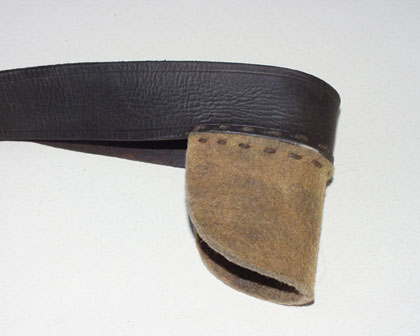
View of the feltpad. Because this got lost with most of the surviving originals, this important detail is also neglegted with most of todays reproductions. This pad is not meant to prevent the bandoliers belt from cutting into the shoulder, but to reduce the pressure of the heavy muskets, when carried on the shoulder during longer marches. For more conveniance the feltpad can be foulded to the inner the side of the belt..
Musketeers Bandolier, Version 2
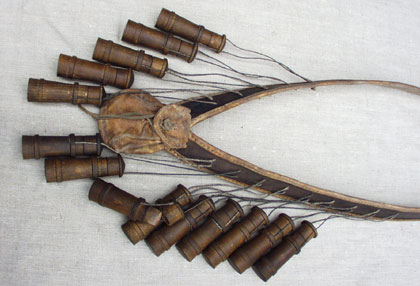
A less luxurious reproduction of a bandolier of styrian origin from the Landeszeughaus Graz. This bandoliers carries 14 powder bottles, which are designed for somewhat stronger charges, compared to the model above. The inner bores of the bottles are conically turned out and hold appr. 16,5 gramms or 250 grains. This reffers to a corresponding musket bore of 18 mm calibre or 15 bullets to the (Nurnberg) pound. Leather lining and bullet pouch are hand sewn and extremely durable..
With this very robust bandolier the advice of the brave colonel Haslang was taken into consideration by attaching the bottles with "good strong twisted strings, that can stand the rain". This strings are treated with shoemakers wax and are extremely durable.
Back to Firearms
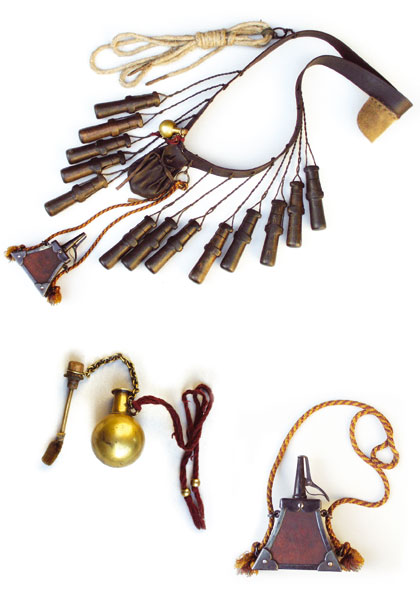 Replica made by Armin Koenig from an original at the Rüstkammer Emden
Replica made by Armin Koenig from an original at the Rüstkammer Emden